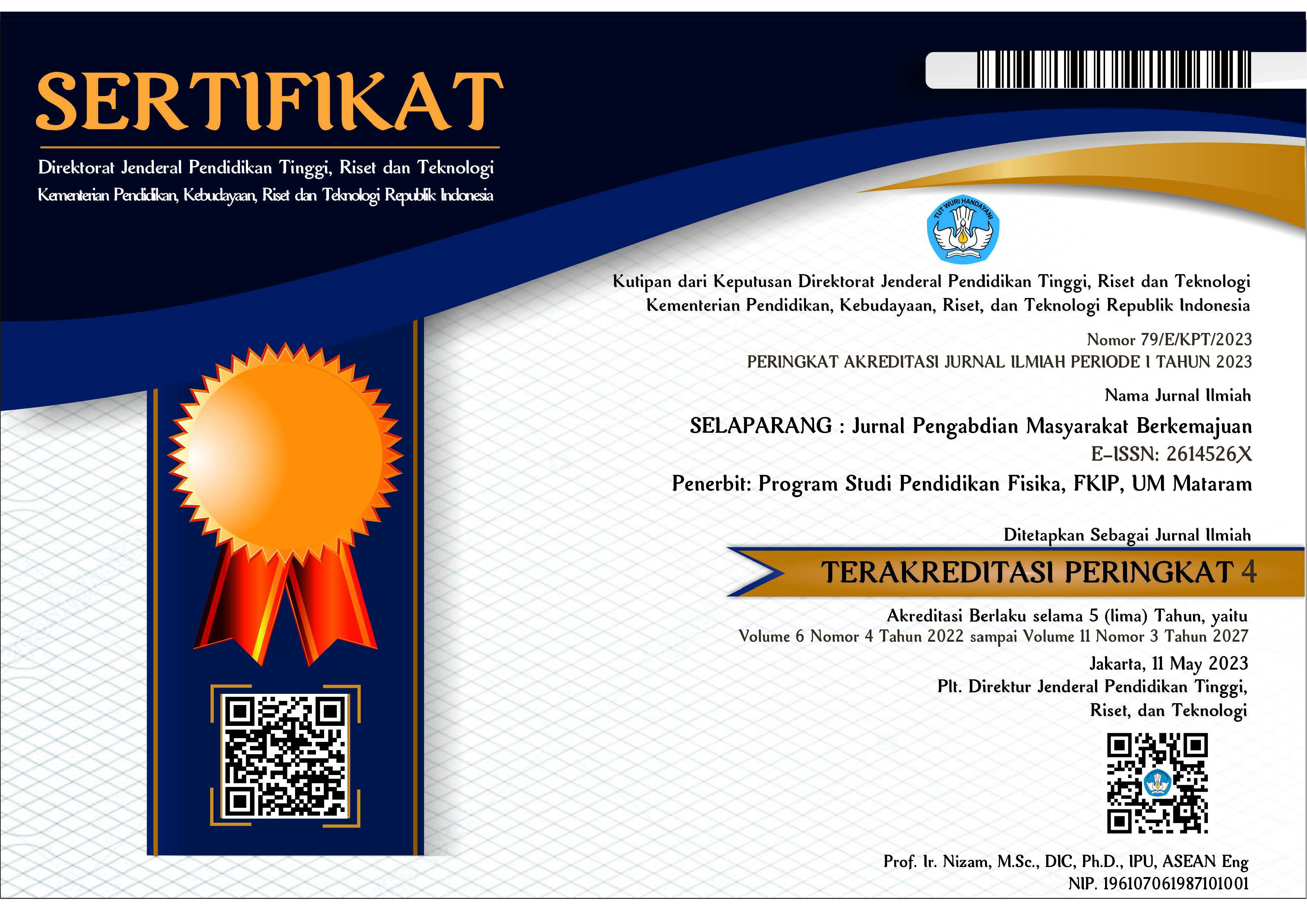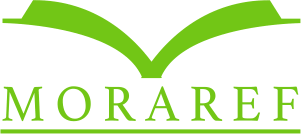Optimalisasi limbah ubi kayu melalui pengolahan fermentasi di sentra sapi potong rakyat sebagai upaya pertanian berkelanjutan di Desa Qurnia Mataram, Lampung Tengah
Abstract
Abstrak
Desa Qurnia Mataram merupakan desa di Kecamatan Seputih Mataram, Kabupaten Lampung Tengah merupakan salah satu pusat pengolahan tepung tapioka. Permasalahan utama yang ditemukan di Desa Qurnia Mataram adalah tingginya jumlah limbah ubi kayu hasil pabrik yang belum dimanfaatkan dengan optimal. Hasil samping pengolahan seperti onggok dan limbah kulit ubi kayu merupakan salah satu pakan alternatif yang dapat digunakan sebagai pakan ternak ruminansia. Selain sebagai sumber industri tepung tapioka, Desa Qurnia Mataram juga merupakan sentra sapi potong. Hal ini dapat menjadi solusi yang potensial terhadap penyediaan pakan bagi ternak sapi potong di Desa Qurnia Mataram. Transfer teknologi yang ditawarkan kepada kelompok tani di desa tersebut adalah pengolahan pakan fermentasi untuk meningkatkan kualitas limbah ubi kayu serta memperpanjang masa simpan pakan. Sehingga penyuluhan ini bertujuan untuk meningkatkan kesejahteraan peternak dalam pembelian pakan. Limbah kulit ubi kayu yang masih memiliki kandungan nutrisi cukup baik dapat menjadi pakan alternatif untuk meningkatkan produktivitas ternak sapi potong sebagai upaya pertanian berkelanjutan di Desa Qurnia Mataram, Lampung Tengah. Setelah kegiatan berlangsung, sebanyak 80% peserta menyatakan mampu mempraktikkan pembuatan pakan fermentasi secara mandiri dan mampu meningkatkan daya suka ternak. Selain itu, solusi ini juga memenuhi aspek kuantitas, kualitas, dan kontinuitas.
Kata kunci: fermentasi; hijauan; limbah ubi kayu; sapi potong; penyuluhan; teknologi pakan
Abstract
Qurnia Mataram Village, located in Seputih Mataram Sub-district, Central Lampung Regency, is one of the centers for tapioca flour processing. A major issue identified in this village is the large amount of cassava waste generated by local processing industries, which remains underutilized. By-products such as onggok (cassava pulp) and cassava peels represent alternative feed that can be used for ruminant livestock. In addition, Qurnia Mataram is also a center for beef cattle farming. This presents a potential solution for addressing the local feed supply challenges for cattle. The technology transfer introduced to farmer groups in the village involved the production of fermented feed to enhance the nutritional quality and shelf life of cassava waste. The outreach program aimed to improve farmers welfare by reducing the cost of feed procurement. Cassava peels, which still contain valuable nutrients, can serve as an alternative feed to improve beef cattle productivity, contributing to sustainable livestock farming in Qurnia Mataram Village, Central Lampung. Following the activity, 80% of participants reported being able to independently produce fermented feed and increased palatability among their livestock. Moreover, this solution effectively addressed the aspects of feed quantity, quality, and continuity.
Keywords: beef cattle; cassava waste; dissemination; feed technology; fermentation; forage
Keywords
Full Text:
PDFReferences
Azad, M.B. et al. (2021) ‘Breastfeeding and the origins of health: Interdisciplinary perspectives and priorities’, Maternal & Child Nutrition, 17(2), p. e13109. Available at: https://doi.org/10.1111/mcn.13109.
Burhan, R. et al. (2023) ‘Comprehensive Breastfeeding Education: An Integration to Support Successful Breastfeeding Practice’, Media Gizi Indonesia, 18(1SP), pp. 46–54. Available at: https://doi.org/10.20473/mgi.v18i1SP.46-54.
Değer, M.S., Sezerol, M.A. and Altaş, Z.M. (2023) ‘Breastfeeding Self-Efficacy, Personal Well-Being and Related Factors in Pregnant Women Living in a District of Istanbul’, Nutrients, 15(21), p. 4541. Available at: https://doi.org/10.3390/nu15214541.
Dunne, S. and Fallon, A. (2020) ‘Public health nurses’ experiences of supporting women to breastfeed in community settings in Ireland’, Journal of Health Visiting, 8(6), pp. 240–246. Available at: https://doi.org/10.12968/johv.2020.8.6.240.
Exclusive breastfeeding for optimal growth, development and health of infants (no date). Available at: https://www.who.int/tools/elena/interventions/exclusive-breastfeeding (Accessed: 2 February 2025).
Farah, E. et al. (2021) ‘Impaired Lactation: Review of Delayed Lactogenesis and Insufficient Lactation’, Journal of Midwifery & Women’s Health, 66(5), pp. 631–640. Available at: https://doi.org/10.1111/jmwh.13274.
Fraser, M. et al. (2020) ‘Important times for breastfeeding support: a qualitative study of mothers’ experiences’, International Journal of Health Promotion and Education [Preprint]. Available at: https://www.tandfonline.com/doi/abs/10.1080/14635240.2019.1676811 (Accessed: 2 February 2025).
Gallegos, D. et al. (2020) ‘Understanding breastfeeding behaviours: a cross-sectional analysis of associated factors in Ireland, the United Kingdom and Australia’, International Breastfeeding Journal, 15(1), p. 103. Available at: https://doi.org/10.1186/s13006-020-00344-2.
Habib, F. et al. (2021) ‘Factors Affecting Mothers’ Self Efficacy and Breastfeeding Practices’, Indonesian Journal of Global Health Research, 3(2), pp. 259–270. Available at: https://doi.org/10.37287/ijghr.v3i2.488.
Kehinde, J., O’Donnell, C. and Grealish, A. (2023) ‘The effectiveness of prenatal breastfeeding education on breastfeeding uptake postpartum: A systematic review’, Midwifery, 118, p. 103579. Available at: https://doi.org/10.1016/j.midw.2022.103579.
Kusuma, N.I. and Khofiyah, N. (2022) ‘Practical support for breastfeeding mothers in achieving exclusive breastfeeding: A scoping review’, JKKI : Jurnal Kedokteran dan Kesehatan Indonesia, pp. 308–320. Available at: https://doi.org/10.20885/JKKI.Vol13.Iss3.art11.
Muda, C.M.C. et al. (2019) ‘Postnatal breastfeeding education at one week after childbirth: What are the effects?’, Women and Birth, 32(2), pp. e243–e251. Available at: https://doi.org/10.1016/j.wombi.2018.07.008.
Munns, L. et al. (2024) ‘The effects of yoga-based interventions on postnatal mental health and well-being: A systematic review’, Heliyon, 10(3), p. e25455. Available at: https://doi.org/10.1016/j.heliyon.2024.e25455.
Murphy, R. et al. (2022) ‘Women’s experiences of initiating feeding shortly after birth in Ireland: A secondary analysis of quantitative and qualitative data from the National Maternity Experience Survey’, Midwifery, 107, p. 103263. Available at: https://doi.org/10.1016/j.midw.2022.103263.
Nilsson, I.M.S. et al. (2020) ‘The significance of early breastfeeding experiences on breastfeeding self-efficacy one week postpartum’, Maternal & Child Nutrition, 16(3), p. e12986. Available at: https://doi.org/10.1111/mcn.12986.
Probowati, R. et al. (2024) ‘The Correct Breastfeeding Education on the Knowledge and Behavior of Postpartum Mothers in the NNICU Room’, Journal of Applied Nursing and Health, 6(1), pp. 162–169. Available at: https://doi.org/10.55018/janh.v6i1.188.
Rosyidah, H., Khadka, S. and Sunah (2024) ‘Breastfeeding education training program for healthcare professionals: A narrative review’, Journal of Health Technology Assessment in Midwifery, 7(1), pp. 43–49. Available at: https://doi.org/10.31101/jhtam.3538.
Theodorah, D.Z. and Mc’Deline, R.N. (2021) ‘“The kind of support that matters to exclusive breastfeeding” a qualitative study’, BMC Pregnancy and Childbirth, 21(1), p. 119. Available at: https://doi.org/10.1186/s12884-021-03590-2.
Tomori, C. et al. (2022) ‘What works to protect, promote and support breastfeeding on a large scale: A review of reviews’, Maternal & Child Nutrition, 18(Suppl 3), p. e13344. Available at: https://doi.org/10.1111/mcn.13344.
Yaumi, Muhammad dan Damopolii, M. (2014) Action Research : Teori, Model, dan Aplikasi. Jakarta: Kencana.
DOI: https://doi.org/10.31764/jpmb.v9i4.31511
Refbacks

This work is licensed under a Creative Commons Attribution-ShareAlike 4.0 International License.
______________________________________________________
Jurnal Selaparang
p-ISSN 2614-5251 || e-ISSN 2614-526X
EDITORIAL OFFICE:



















